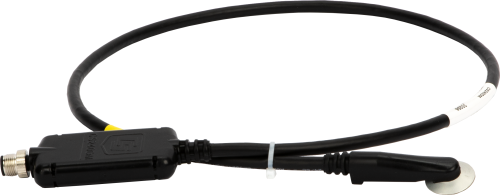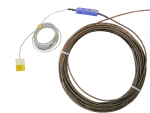This product has limited availability. It will be replaced by: CS241DM. Some accessories, replacement parts, or services may still be available when it is no longer available.

Class A accuracy, best-in-class performance






Overview
The CS240DM is a best-in-class smart sensor with a rugged, surface-mountable platinum resistive thermometer (PRT) that measures back-of-module temperature on solar photovoltaic (PV) panels. The CS240DM includes a new Campbell Scientific precision analogue-to-digital, smart-sensor module that makes back-of-module temperature measurements that are among the most accurate measurements available today.
Read MoreBenefits and Features
- Best-in-class measurement accuracy and technology
- Modbus RTU RS-485 digital serial communications
- Precision Pt1000 Class A sensing element
- Compliant with IEC 60751, DIN EN 60751
- Meets 61724-1 PV System Performance Standard
- Optional NIST traceable calibration certificate
- Purchased with any cable length
- Rugged design proven in more than 4,000 installations worldwide
Technical Description
The CS240DM consists of a Pt-1000 Class A PRT encased in an aluminum disk. The disk protects the PRT, particularly during installation when pulled through conduit, and promotes heat transfer from the surface while minimizing convective heat loss to the surroundings. An adhesive tab on the disk fastens the CS240DM to the measurement surface. If the temperature may exceed 70°C, Kapton tape is also required to secure the probe.
The precision analog-to-digital, smart-sensor module is based on the CR1000X. The module design is optimized for the Class A PRT that minimizes self-heating and lead-wire resistance. Measurement electronics are surge protected, include 1200 V isolation, and are environmentally protected with a rugged over-molding featuring an IP65 rating. Data is differentially transmitted in cabling that is well suited for industrial energy applications with excellent noise rejection and high voltage, NEC outdoor, UV, UL, and NEC ratings.
The CS240DM provides PV stakeholders with highly accurate back-of-module temperature—even at long cable lengths—for use in power-performance modeling and simulation of solar energy applications. Back-of-module temperature is critical for any evaluation of effective irradiance and power conversion.
Images








Specifications
| Sensor | Platinum resistive thermometer (PRT) |
| System Uncertainty | ±0.3°C |
| Disk Material | Anodized aluminum |
| Surge Protection | 1200 V isolation |
| Supply Voltage of the Sensor | 5 to 30 Vdc |
| Power Draw | 15 mA |
| Compliance Information |
|
| Conforms with Electromagnetic Compatibility Directive | (EMC) |
| Conforms with the Restriction of Hazardous Substances Directive | (RoHS2) |
| Disk Diameter | 2.54 cm (1.0 in.) |
| Overall Probe Length | 6.35 cm (2.5 in.) |
| Overmolded Joint Dimensions | 5.72 x 1.12 x 1.47 cm (2.25 x 0.44 x 0.58 in.) |
| Weight | 90.7 g with 3.2 m cable (0.2 lb with 10.5 ft cable) |
Sensing Element |
|
| Precision | 1000 ohm Class A platinum sensing element (Pt-1000) |
| Accuracy | ±(0.15 + 0.002T)°C |
| Temperature Coefficient of Resistance | TCR = 3850 ppm/K |
| Long-Term Stability | Maximum Ro drift 0.04% (after 1000 h at 400°C) |
| Operating Temperature Range | -40° to +135°C |
Communications |
|
| Protocol | Modbus RTU protocol (over RS-485) |
| Format | 8 data bits, 1 stop bit, even parity as default (user-configurable) |
| Baud Rate | 19,200 bps as default (user-configurable) |
| Modbus ID | Last two digits of serial number as default (user-configurable) |
Cable |
|
| Description |
|
| Jacket Material | Black semi-gloss PVC, UL VW-1 sunlight resistant for outdoor use |
| Agency Approvals |
|
| Nominal Wire Diameter | 0.61 mm (0.024 in.) |
Resources and Links
Listed Under
FAQs for
Number of FAQs related to CS240DM: 4
Expand AllCollapse All
-
Even when three-pt calibration isn’t ordered, when we build the probes, we perform a final test to verify that they are reading within 0.3°C of our calibrated reference sensor at room temperature.
-
A hot spot is caused if a cell in series is under-producing due to shading and gets reversed bias due to the other producing cells. For bifacial modules, as long as the front face is not shaded, all the cells should be producing and covering a small area on the back side and should not cause a severe mismatch.
-
NIST traceability provides an assurance of accuracy. This is especially desirable in accordance with IEC 61724, which is a specification for monitoring solar energy generation that requires calibrated sensors.
-
Yes, it is NIST traceable.
Case Studies
Project Overview In May of 2021, Vertech embarked on a project to supply their client, DEPCOM......read more
Articles and Press Releases
Newsletter Articles
Privacy Policy Update
We've updated our privacy policy. Learn More
Cookie Consent
Update your cookie preferences. Update Cookie Preferences



